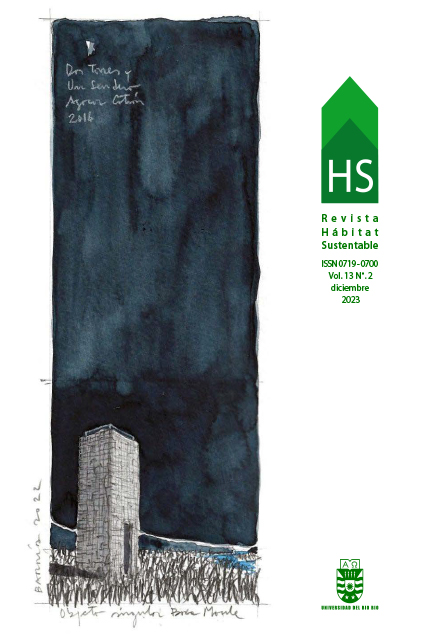Building simple mathematical models to calculate the energy requirements of buildings
DOI:
https://doi.org/10.22320/07190700.2023.13.02.04Keywords:
mathematical modeling, simulations, sustainable architectureAbstract
This work looks to build a predictive mathematical model that can provide a first approach to a building’s energy requirement (ER) value in a temperate continental climate. The aim is to contribute to the theoretical knowledge of energy assessment tools. To do this, parametric simulations were run and processed using the EnergyPlus 9.5 and JePlus programs. The results were then used as a dataset to build different mathematical models, using the SageMath program to run equations that predicted the ER of each scenario. Work was done with the models, scaling their complexity with the methods and the number of parameters used. Finally, a model with a low error (0.08) and 15 parameters was chosen. It was noted that, although increasing the number of parameters brought the models closer to a 0.02 error, there was a risk of overfitting. The chosen model seeks to incorporate dynamic simulations' accuracy and validity into a simple prediction tool that construction professionals can apply.
Downloads
References
AZAR, E., ALAIFAN, B., LIN, M., TREPCI, E., & ASMAR, M. E. (2021). Drivers of energy consumption in Kuwaiti buildings: insights from a hybrid statistical and building performance simulation approach. Energy Policy, 150, 112154. https://doi.org/10.1016/j.enpol.2021.112154
CĂTĂLINA, T., IORDACHE, V., & CARACALEANU, B. (2013). Multiple regression model for fast prediction of the heating energy demand. Energy and Buildings, 57, 302–312. https://doi.org/10.1016/j.enbuild.2012.11.010
CHANG, C. C., SHI, W., MEHTA, P., & DAUWELS, J. (2019). Life cycle energy assessment of university buildings in tropical climate. Journal of Cleaner Production, 239, 117930. https://doi.org/10.1016/j.jclepro.2019.117930
CHOU, J., & NGO, N. (2016). Time series analytics using sliding window metaheuristic optimization-based machine learning system for identifying building energy consumption patterns. Applied Energy, 177, 751–770. https://doi.org/10.1016/j.apenergy.2016.05.074
GONZÁLEZ-VIDAL, A., RAMALLO-GONZÁLEZ, A. P., TERROSO-SÁENZ, F., & SKARMETA, A. F. (2017). Data driven modeling for energy consumption prediction in smart buildings. 2017 IEEE International Conference on Big Data (Big Data). https://doi.org/10.1109/bigdata.2017.8258499
HUANG, S., LIN, Y., CHINDE, V., MA, X., & LIAN, J. (2021). Simulation-based performance evaluation of model predictive control for building energy systems. Applied Energy, 281, 116027. https://doi.org/10.1016/j.apenergy.2020.116027
INTERNATIONAL ENERGY AGENCY (2022). Tracking Buildings 2022. Paris: International Energy Agency. https://www.iea.org/ energy-system/buildings
KWAK, Y. H., SEO, D., JANG, C., & HUH, J. (2013). Feasibility study on a novel methodology for short-term real-time energy demand prediction using weather forecasting data. Energy and Buildings, 57, 250–260. https://doi.org/10.1016/j.enbuild.2012.10.041
MALKAWI, A., & AUGENBROE, G. (2004). Advanced Building Simulation. Routledge. https://doi.org/10.4324/9780203073674
PAPADOPOULOS, S., AZAR, E., WOON, W. L., & KONTOKOSTA, C. E. (2017). Evaluation of tree-based ensemble learning algorithms for building energy performance estimation Journal of Building Performance Simulation, 11(3), 322–332. https://doi.org/10.1080/19401493.2017.1354919
RAJ, B. P., MEENA, C. S., AGARWAL, N., SAINI, L., KHAHRO, S. H., SUBRAMANIAM, U., & GHOSH, A. (2021). A Review on Numerical Approach to Achieve Building Energy Efficiency for Energy, Economy and Environment (3E) benefit. Energies, 14(15), 4487. https://doi.org/10.3390/en14154487
SCHWARTZ, Y., & RASLAN, R. (2013). Variations in results of building energy simulation tools, and their impact on BREEAM and LEED ratings: A case study. Energy and Buildings, 62, 350–359. https://doi.org/10.1016/j.enbuild.2013.03.022
SEYEDZADEH, S., RAHIMIAN, F. P., RASTOGI, P., & GLESK, I. (2019). Tuning machine learning models for prediction of building energy loads. Sustainable Cities and Society, 47, 101484. https://doi.org/10.1016/j.scs.2019.101484
HARPUTLUGIL, T., & DE WILDE, P. (2021). The interaction between humans and buildings for energy efficiency: A critical review. Energy Research & Social Science, 71, 101828. https://doi.org/10.1016/j.erss.2020.101828
UNITED NATIONS ENVIRONMENT PROGRAMME (2022). 2022 Global Status Report for Buildings and Construction: Towards a Zero emission, Efficient and Resilient Buildings and Construction Sector. https://www.unep.org/resources/publication/2022-global-status-report-buildings-and-construction
FANG, Y., & CHO, S. (2019). Design optimization of building geometry and fenestration for daylighting and energy performance. Solar Energy, 191, 7–18. https://doi.org/10.1016/j.solener.2019.08.039
YE, Y., HINKELMAN, K., ZHANG, J., ZUO, W., & WANG, G. (2019). A methodology to create prototypical building energy models for existing buildings: A case study on U.S. religious worship buildings. Energy and Buildings, 194, 351–365. https://doi.org/10.1016/j.enbuild.2019.04.037
ZHAO, H., & MAGOULÈS, F. (2012). A review on the prediction of building energy consumption. Renewable & Sustainable Energy Reviews, 16(6), 3586–3592. https://doi.org/10.1016/j. rser.2012.02.049
Downloads
Published
How to Cite
Issue
Section
License
Copyright (c) 2023 María Victoria Mercado, Gustavo Javier Barea-Paci, Andrés Esteban Aceña

This work is licensed under a Creative Commons Attribution-ShareAlike 4.0 International License.
The content of articles which are published in each edition of Habitat Sustentable, is the exclusive responsibility of the author(s) and does not necessarily represent the thinking or compromise the opinion of University of the Bio-Bio.
The author(s) conserve their copyright and guarantee to the journal, the right of first publication of their work. This will simultaneously be subject to the Creative Commons Recognition License CC BY-SA, which allows others to share-copy, transform or create new materials from this work for non-commercial purposes, as long as they recognize authorship and the first publication in this journal, and its new creations are under a license with the same terms.











 Scientific Information Program/Concurso Fondos de Publicación de Revistas Científicas 2018/ Proyecto Mejoramiento de Visibilidad de Revistas UBB (Código:FP180007).
Scientific Information Program/Concurso Fondos de Publicación de Revistas Científicas 2018/ Proyecto Mejoramiento de Visibilidad de Revistas UBB (Código:FP180007).





